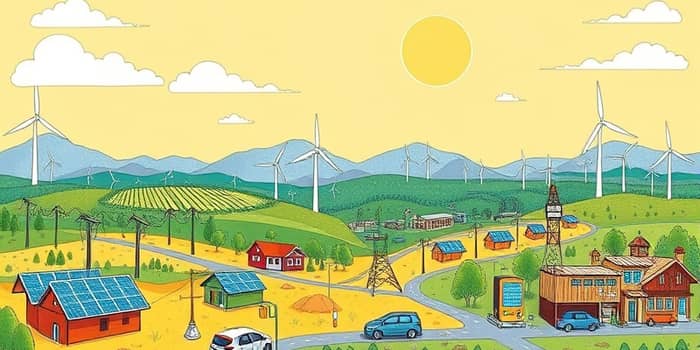The world stands at a crossroads. As traditional energy sources wane and climate risks intensify, there is a compelling case for channeling unprecedented resources into clean power. The journey toward a sustainable tomorrow is both a challenge and an opportunity, inviting investors, policymakers, and communities to collaborate and redefine our collective energy landscape.
Global Investment Trends
In 2025, global energy investment is poised to reach an astonishing $3.3 trillion, with twice as much going to clean energy as to fossil fuels. This reflects a paradigm shift: renewables investment alone is expected to hit $780 billion, up 109% since 2015. Solar now attracts more capital than oil, and overall electricity investment has outpaced fossil fuels, signaling a historic reversal of the previous decade’s dynamics.
Despite this momentum, experts warn that current funding falls short of the $5.6 trillion annual average needed between 2025 and 2030 to stay on a net zero path by 2050. In the first half of 2025, $386 billion flowed into new renewable projects, a 10% year-on-year increase, yet still below the scale required to meet climate targets.
- Clean energy investment in 2024: record $2.1 trillion (11% YoY increase)
- Renewables capacity growth in 2024: +600 GW
- EV sales growth in 2024: +25%
- Operational battery storage deployments: nearly doubled
Technological Milestones
Rapid innovation has driven cost declines and performance leaps. Solar module prices fell 35% to just $0.09 per watt, while EV battery prices are below $100 per kilowatt-hour, reaching cost parity with combustion engines. These breakthroughs are democratizing access to clean power and accelerating adoption across markets.
Renewables-based generation is set to overtake coal-fired power globally in 2025—a monumental milestone. Battery storage deployments are bridging intermittency gaps, and digital grid management systems are optimizing energy flows in real time. Innovations in green hydrogen, advanced biofuels, and modular nuclear reactors also promise to diversify and strengthen the clean energy toolkit.
Regional Dynamics and Policy Drivers
Investment patterns vary widely by region. In the first half of 2025, U.S. renewable investment fell 36% amid policy uncertainty, while the European Union saw a capital shift toward clean energy projects. Early adopters like China and the UK continue to lead deployment, driving down costs and sharing lessons globally.
Governments are recalibrating priorities around energy security, resilience, and supply chain integrity. National policies now emphasize critical minerals sourcing, domestic manufacturing of solar panels and batteries, and incentives for grid modernization. This strategic approach aims to reduce dependencies on traditional hydrocarbons and fortify supply chains against geopolitical shocks.
Overcoming Challenges and Building Resilience
Despite impressive progress, several headwinds threaten to stall momentum. Grid limitations in mature markets constrain further scaling of renewables, while revenue uncertainty—negative power prices and curtailment—deters large-scale investors. At the same time, greenwashing and accountability gaps undermine confidence in many net zero pledges.
- Grid and storage constraints hampering integration
- Revenue uncertainty from price volatility
- Lack of credible monitoring and enforcement
- Record-high global CO₂ emissions despite progress
Addressing these challenges requires targeted investment in grid expansion, advanced storage solutions, and transparent reporting frameworks. Stakeholders must prioritize policies that guarantee both environmental integrity and financial viability.
Investment Priorities for a Secure Future
The next phase of the energy transition demands a holistic, multidimensional strategy. Investors and policymakers should align on four critical priorities:
- Boosting investment in transmission and distribution networks
- Scaling up battery and hydrogen storage technologies
- Fostering digital innovation for smarter grids
- Ensuring equitable access and local supply chain development
By focusing on these areas, the industry can build resilient systems capable of withstanding shocks, while driving down costs and accelerating clean energy deployment. Integrating decentralized energy resources, such as rooftop solar and community microgrids, further enhances resilience and empowers local stakeholders.
Comparing Required and Actual Investment
Charting a Path to Net Zero
Global authorities stress the need to holistic national climate plans that extend beyond headline targets to enforceable policies. Key areas of focus include ramping up mineral supply for batteries and solar panels, accelerating grid upgrades, and fostering international collaboration on research and development.
Energy equity and access remain central to long-term success. Emerging markets must share in the benefits of clean energy through job creation, technology transfer, and investment in local infrastructure. Public-private partnerships can catalyze these outcomes, ensuring that the energy transition advances both climate goals and socioeconomic development.
Ultimately, the transition to clean energy is not solely an environmental imperative but a catalyst for innovation, economic growth, and global security. By seizing this moment, stakeholders worldwide can invest in a future that is cleaner, more resilient, and more prosperous for all.
References
- https://rmi.org/the-energy-transition-in-2025-what-to-watch-for/
- https://about.bnef.com/insights/clean-energy/global-renewable-energy-investment-reaches-new-record-as-investors-reassess-risks/
- https://www.imd.org/ibyimd/industry/energy/5-things-to-know-about-the-energy-transition-in-2025/
- https://www.visualcapitalist.com/charted-the-shift-in-global-energy-investment-2015-2025/
- https://www.rff.org/publications/reports/global-energy-outlook-2025/
- https://www.iigcc.org/insights/world-energy-investment-2025-highlights-electricity-demand-and-energy-security-new-drivers
- https://www.weforum.org/publications/fostering-effective-energy-transition-2025/in-full/redefining-global-energy-systems/
- https://www.axios.com/2025/08/26/us-investments-renewable-energy-projects-numbers










